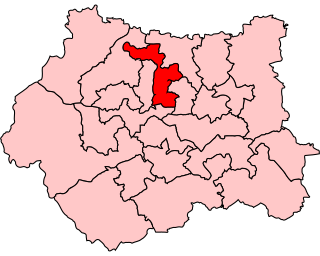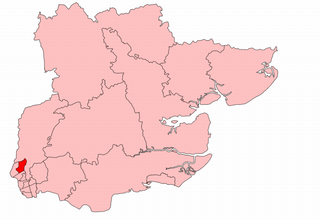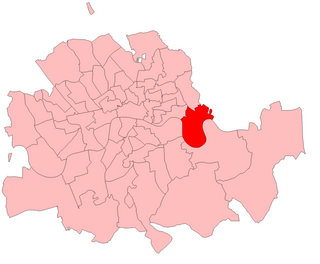
Birmingham Edgbaston is a constituency, represented in the House of Commons of the UK Parliament since 2017 by Preet Gill, a Labour Co-op MP.

Dewsbury is a constituency created in 1868. This seat is represented in the House of Commons of the United Kingdom Parliament since 2019 by Mark Eastwood of the Conservative Party.

Pudsey is a constituency represented in the House of Commons of the UK Parliament since 2010 by Stuart Andrew, a Conservative.

Bradford East is a constituency in West Yorkshire represented in the House of Commons of the UK Parliament since 2015 by Imran Hussain of the Labour Party.

Woolwich East was a parliamentary constituency represented in the House of Commons of the Parliament of the United Kingdom from 1918 until 1983. Its seat was Woolwich, now in the Royal Borough of Greenwich in south-east London.

Hornsey was a constituency that returned one Member of Parliament (MP) to the House of Commons of the UK Parliament, 1885 — 1983. It was then largely replaced by Hornsey & Wood Green. Its voters using the first-past-the-post system elected the Conservative Party candidate at each election. Its closest result was a 1.29% majority at the 1966 election which saw the start of the Second Wilson Ministry. From 1945 onwards the runners-up in the seat were the Labour Party candidates.
Bedwellty was a county constituency in Monmouthshire which returned one Member of Parliament (MP) to the House of Commons of the Parliament of the United Kingdom from 1918 until it was abolished for the 1983 general election.
Bethnal Green was a parliamentary constituency in the Bethnal Green area of the East End of London, which returned one Member of Parliament (MP) to the House of Commons of the Parliament of the United Kingdom from 1950 until it was abolished for the February 1974 general election.
Chislehurst was a parliamentary constituency in what is now the London Borough of Bromley. It returned one Member of Parliament (MP) to the House of Commons of the Parliament of the United Kingdom.

Walthamstow East was a parliamentary constituency in what was then the Municipal Borough of Walthamstow in east London. It returned one Member of Parliament (MP) to the House of Commons of the Parliament of the United Kingdom, elected by the first-past-the-post voting system.
Pontypool was a county constituency in the town of Pontypool in Monmouthshire. It returned one Member of Parliament (MP) to the House of Commons of the Parliament of the United Kingdom, elected by the first past the post voting system.
Nottingham West was a borough constituency in the city of Nottingham. It returned one Member of Parliament (MP) to the House of Commons of the Parliament of the United Kingdom.
Brigg and Scunthorpe was a parliamentary constituency centred on the towns of Brigg and Scunthorpe in Humberside. It returned one Member of Parliament (MP) to the House of Commons of the Parliament of the United Kingdom.
Melton was a county constituency centred on the town of Melton Mowbray in Leicestershire. It returned one Member of Parliament (MP) to the House of Commons of the Parliament of the United Kingdom.

Poplar was a parliamentary constituency centred on the Poplar district of the East End of London. It returned one Member of Parliament (MP) to the House of Commons of the Parliament of the United Kingdom.
Denbigh was a county constituency centred on the town of Denbigh in North Wales. It returned one Member of Parliament (MP) to the House of Commons of the Parliament of the United Kingdom, elected by the first-past-the-post voting system.
West Ham South was a parliamentary constituency in the County Borough of West Ham, in what was then Essex but is now Greater London. It returned one Member of Parliament (MP) to the House of Commons of the Parliament of the United Kingdom, elected by the first-past-the-post voting system.
Rhondda West was a parliamentary constituency centred on the Rhondda district of Wales. It returned one Member of Parliament (MP) to the House of Commons of the Parliament of the United Kingdom, elected by the first past the post system. Along with Rhondda East it was formed by dividing the old Rhondda constituency.
West Ham North was a borough constituency in the County Borough of West Ham, in what was then Essex but is now Greater London. It returned one Member of Parliament (MP) to the House of Commons of the Parliament of the United Kingdom, elected by the first-past-the-post voting system.












